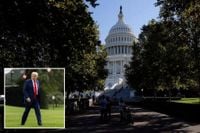On October 10, 2025, the White House budget office set off a political firestorm by announcing that mass firings of federal workers had begun, marking a dramatic escalation in the ongoing government shutdown, which had by then entered its tenth day. The move, orchestrated under President Donald Trump’s administration, aimed to increase pressure on congressional Democrats to resolve the budget impasse, but it quickly drew fierce criticism from both sides of the political aisle and sent shockwaves through the federal workforce.
According to court filings and official statements reported by the Associated Press and other major outlets, more than 4,000 federal employees were slated for termination as part of sweeping reduction-in-force (RIF) plans. The hardest-hit agencies included the Department of the Treasury, which stood to lose over 1,400 employees, and the Department of Health and Human Services, where up to 1,200 jobs were on the chopping block. The Education Department and Housing and Urban Development each faced the loss of more than 400 staffers, while the Departments of Commerce, Energy, and Homeland Security, along with the Environmental Protection Agency (EPA), prepared to cut hundreds more.
The scale and abruptness of these layoffs went far beyond the typical response to a government shutdown. Traditionally, federal workers are furloughed—temporarily sent home without pay—but are almost always reinstated with back pay once funding is restored. This time, however, the Trump administration signaled a more aggressive approach, with permanent job losses looming large. As Russ Vought, director of the Office of Management and Budget, declared on social media, "RIFs have begun," confirming the administration’s intent to follow through on earlier warnings.
In the Oval Office, President Trump made no effort to downplay the severity of the situation. "It’ll be a lot, and we’ll announce the numbers over the next couple of days," he told reporters, adding pointedly, "But it’ll be a lot of people." Trump further indicated that the firings would be focused on what he described as "Democrat-oriented areas," though he did not elaborate on the criteria for such targeting. "These are people that the Democrats wanted, that, in many cases, were not appropriate," he said. "Many of them will be fired."
The administration’s tactics drew immediate condemnation from Democrats and even some Republicans. Senate Minority Leader Chuck Schumer was unequivocal in his assessment: "Let’s be blunt: nobody’s forcing Trump and Vought to do this. They don’t have to do it; they want to. They’re callously choosing to hurt people—the workers who protect our country, inspect our food, respond when disasters strike. This is deliberate chaos."
Prominent Republicans also voiced their objections. Senator Susan Collins of Maine, chair of the Senate Appropriations Committee, criticized the move as "a completely unnecessary government shutdown" and said, "I strongly oppose OMB Director Russ Vought’s attempt to permanently lay off federal workers who have been furloughed." Alaska Senator Lisa Murkowski called the announcement "poorly timed" and "yet another example of this administration’s punitive actions toward the federal workforce."
Notices of layoffs began arriving at several federal agencies, creating confusion and anxiety among employees. The Education Department, for example, confirmed that nearly all staff below the director level in the Office of Elementary and Secondary Education were being let go, while the Office of Communications and Outreach saw fewer than ten terminations. The Cybersecurity and Infrastructure Security Agency (CISA), a key player in defending the nation’s digital and physical infrastructure, was another target. According to filings cited by The New York Post, CISA planned to fire as many as 2,540 employees and furlough 65% of its workforce—a move that some observers saw as particularly concerning given the agency’s role in countering misinformation and safeguarding critical systems.
At the EPA, a spokesperson pointed the finger at Democrats, saying they could "vote to reopen the government anytime," even as the agency prepared to notify 20-30 employees of potential future terminations. The United States Patent and Trademark Office also issued reduction-in-force notices to 126 employees at the very start of the shutdown on October 1.
The American Federation of Government Employees (AFGE), the largest federal employee union, quickly filed a legal challenge to halt the firings. In a legal filing, the union argued that the layoffs constituted an abuse of power designed to punish workers and pressure Congress. AFGE President Everett Kelley said in a statement, "It is disgraceful that the Trump administration has used the government shutdown as an excuse to illegally fire thousands of workers who provide critical services to communities across the country." The Department of Justice, however, countered in court that the required 30- or 60-day notice periods for federal layoffs meant that no "irreparable harm" would occur immediately. District Judge Susan Illston scheduled a hearing for October 16 to weigh the union’s request for a temporary restraining order.
Meanwhile, the shutdown’s impact continued to ripple across the country. About 750,000 federal employees were expected to be furloughed, and many agencies braced for operational slowdowns or outright disruptions. The halls of Congress remained eerily quiet, with both the House and Senate largely absent from Washington and little sign of progress in bipartisan negotiations. Senate Majority Leader John Thune and Speaker of the House Mike Johnson were among the few visible figures still pressing for a resolution, but Democrats held firm, demanding a commitment to extend health care benefits before agreeing to any stopgap funding bill.
Some Republicans on Capitol Hill acknowledged that the administration’s threats of mass layoffs were not helping bipartisan talks. The top Democrat on the Senate Appropriations Committee, Senator Patty Murray, insisted that "the shutdown does not give Trump or Vought new, special powers" to lay off workers, dismissing the move as intimidation. Outside observers, like Max Stier of the Partnership for Public Service, warned that "these unnecessary and misguided reductions in force will further hollow out our federal government, rob it of critical expertise and hobble its capacity to effectively serve the public."
For federal workers, the uncertainty was palpable. Many wondered which programs and services would be affected and whether their own jobs would be next. With the shutdown showing no sign of ending and bipartisan negotiations at a standstill, the fate of thousands hung in the balance. As the days dragged on, the Trump administration’s aggressive strategy had transformed a routine budget standoff into a high-stakes showdown with real consequences for the nation’s civil servants and the public they serve.
As the shutdown’s tenth day drew to a close, one thing was clear: the political and human costs of this standoff were mounting, with no easy solution in sight.




